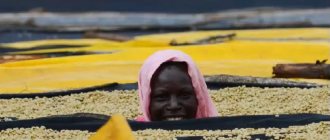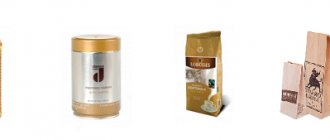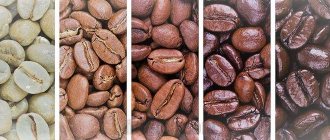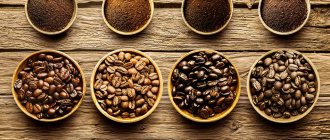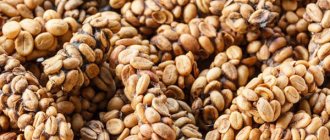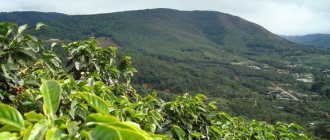The concepts of “types of coffee” and “grades of coffee” are often confused. Species are botanical varieties of plants; more than a hundred of them are grown, but only four of them are suitable for consumption. Varieties are various breeding hybrids based on species, but today we also mean a huge assortment of store brands.
Major global suppliers of coffee products
Coffee is produced in more than 50 countries around the world. Main importers of products:
- Brazil . The main varieties of coffee in the world are produced there. It imports 35% of coffee products, producing it using a dry processing method, and the quality of the drink then suffers.
- Vietnam . Over the past few years, it produces 20% of the world's coffee. Traditional exporters are Russia, Germany, Great Britain.
- Colombia . Produces the world's best Arabica coffee, which is known for its balanced taste.
- Mexico . It produces coffee in large volumes, but only the product that is grown on the mountain slopes is of interest. The rest is usually used in preparing mixtures.
- Nicaragua . Makes a strong drink with a sour taste, obtained after wet processing.
- Ethiopia . Varieties produced in the east of the country are known for their high acidity and winey taste, while those from the south have a bright, rich aroma and fruity taste.
- India . Produces monsoon green coffee with aromas of cardamom, nutmeg and cloves.
- Sumatra . The homeland of many varieties of drink with a bright taste and bitter smell.
In Russia, the prevalence of ground and bean coffee is constantly increasing, and in terms of the level of consumption of instant products, our country ranks first in the world ranking
By type of grinding
To make coffee, you need to grind the fruits. In everyday life, the degree of grinding is determined by touch.
Large
The maximum particle diameter is 1 mm and resembles coarse salt in appearance. It is obtained after grinding the beans in a home coffee grinder for 10 seconds. It is not found in retail sales; it is more often used during tastings.
Average
This method is universal. Coffee resembles fine sand. To obtain it, it is enough to hold the fruits in a coffee grinder for 10-15 seconds.
Small
The grains are ground to fine salt or powder. The first option is ideal for a coffee machine, the second - for brewing in a Turk. Grinding duration is up to 20 seconds. This releases caffeine, which contributes to bitterness.
How many varieties of coffee are there in the world?
The number of existing types of coffee cannot be accurately counted; there are more than a thousand options.
The most common coffee variety in the world is Arabica . Next in popularity is Congolese coffee, also known as Robusta . Less common are Liberica and Excelsa .
Liberica
Liberian coffee (lat. Cofféa liberica) is the third most common coffee after Arabica and Robusta. Liberica trees differ from many of their “relatives” in their high growth (up to 10 - 18 meters), slenderness, beautiful large leaves and large fruits up to 3.0 cm in length! They are resistant to most diseases, but require moisture; in unfavorable seasons they do not bear fruit, but do not die. Coffee grows wild in the north of the African continent. Sri Lanka, on the Indonesian and Philippine islands. It has a mild taste due to its low caffeine content, but has a strong aroma, which is why Liberica varieties are often used in blends, especially in the Philippines. Liberica is often used in the confectionery industry as a flavoring due to its distinct coffee smell. “Jasmine” tea is produced from the flowers; it is even more aromatic than that brewed from real jasmine.
Features of growing Liberica coffee in an apartment
The conditions required for growing Liberica indoors are almost the same as for Robusta or Arabica. But due to the characteristics of the species: large size and large leaves, it is more convenient to grow the plant in floor containers (tubs) in office premises or greenhouses.
If you have experience growing this variety, write in the comments!
Characteristics and varieties
Coffee classification includes many indicators. This helps you choose the right drink more accurately.
By type of coffee tree
To obtain coffee, four varieties of the coffee tree are used:
- Arabica;
- robusta;
- liberica;
- Excel.
Arabica - up to 5 kg of fruits are obtained from one plant, which then produces up to 1 kg of coffee. The finished drink has a pleasant sourness and contains little caffeine. Arabica coffee accounts for 70% of the world's coffee. There are 50 known varieties of this plant.
The drink, obtained from robusta , has a high caffeine content and a bitter taste.
Liberica is the third most common coffee tree species, but the crop is entirely consumed locally and almost nothing is exported. This is due to the plant’s demands on growing conditions. The taste of the product is bitter and pungent, which is why it is not drunk in its pure form. It is more often used as a component of coffee blends.
Excelsa is distinguished by the quality of its grains, pleasant and rich taste and aroma. Excelsa is also called a “tall” species, because under natural conditions the plant grows up to 20 meters.
By type of coffee beans
To determine the size of coffee beans, a concept called “screen” is used. These are special sieves with holes of different sizes. The holes in the upper sieves are the largest, and the smaller ones in the lower ones. One screen is equal to 0.04 cm. To convert screens into centimeters, use the formula: screen/64x2.54.
The generally accepted classification of coffee beans starts from screen 8 and ends on screen 20. Typically, the dimensions of the beans are indicated as follows:
- very small (screen 8-10);
- small (screen 12);
- medium (screen 14);
- large (screen 16-18);
- very large (screen 20).
According to the method of their processing
There are three options for processing grains: dry, wet and honey .
The first case is classic and is used most often. Manufacturers place coffee beans on concrete platforms, palm leaves or special mesh tables for drying.
Drying often occurs in the sun and takes about a month to complete. In other cases, special drying machines are used, into which the grains are loaded after several days of drying under the sun. As soon as the harvest is harvested, it is necessary to immediately sort through the grains, removing unripe ones. If this is not done, then after drying, when all the berries acquire the same color, it will become impossible to separate them from each other.
When drying in the sun, it is necessary to turn the grains every six hours to more evenly remove moisture. Otherwise, there is a risk of mold development and spoiled taste.
During wet processing, bacteria begin to eat the sweet gluten, destroying it. After this, the remaining gluten is washed off with water and sent to dry. Three types of fermentation are used: washed, dry and mechanical. In the first two cases, the seeds are loaded inside a tank with or without water for a day. The mechanical method involves the use of special mechanical devices. There, the grains move at high speed under the influence of water, which is why the gluten is removed. At the end, the grains are sent for drying, which proceeds in the same way as during dry processing.
The honey method is similar to the previous method, but here the berries are dried without removing the gluten. This allows the flavors and sugars from it to be retained in the final product.
By grain quality
According to this indicator, grains can be good (highest grade), medium-grade and low-grade. In the international coffee market, another classification is more common:
- mild - the softest drinks made from Arabica;
- Brazilian - collected in Brazil, they are distinguished by their low cost;
- robusta – all varieties based on robusta.
By country of production
Coffee produced in Central America is famous for its varied flavors. The largest importer of the drink in this region is Mexico. The list of other producers includes: Cuba, Jamaica, El Salvador, Belize, Nicaragua, Panama, Costa Rica, Haiti, Dominican Republic, Puerto Rico, Honduras.
South America accounts for up to half of the world's coffee industry. This region is considered the main supplier of the drink. Here it combines good taste and low price. The main producers are Brazil and Ecuador. The product is also produced in the following countries: Peru, Trinidad and Tobago, Bolivia, Venezuela, Paraguay, Colombia, Guiana, Suriname, Guyana.
All major coffee varieties are produced in Africa. Both Robusta and Arabica, as well as other varieties of coffee beans, are produced here. They are distinguished by their tartness and rich aroma and taste. 15 countries are involved in exports, the main ones being: Ethiopia, Kenya, Angola, South Africa, and Congo.
In Asia, Robusta, Arabica and Liberica are predominantly cultivated. Based on the latter variety, elite drink mixtures are created. The list of producers includes: Vietnam, Yemen, New Guinea, Philippines, Malaysia, Myanmar, China, Indonesia, India, Thailand, East Timor.
By strength
The strength of coffee depends on how much caffeine it contains. This indicator is also influenced by the following factors:
- Type, variety and region of cultivation . Robusta produces a stronger drink than Arabica. The strongest coffee is made in Africa and the Arabian Peninsula.
- Roasting degree . The strength of the drink reaches its maximum with dark roasting.
- Cooking method . To get an invigorating drink, you need to add more ground grains.
- Cooking method . The longer coffee is brewed, the stronger it becomes.
By degree of roasting
The classification of the drink depending on this indicator consists of the following points:
- weak (Scandinavian);
- medium (Viennese);
- strong (French);
- the strongest (Italian).
According to the age
According to the degree of freshness of coffee beans, the product is divided into two main categories: New crop and Old crop . The first category includes fresh grains that have been packaged immediately after harvesting and processing. The second group includes last year's harvest, from which there are unsold leftovers.
Another classification option involves the presence of age levels such as Mature (Old) and Vintage coffee (Aged coffee). The first point includes grains that have been stored for 1-3 years in special warehouses, and the second includes those that have been stored for 4-10 years.
Growing regions
The main coffee growing areas remain Brazil and Colombia, as well as many Asian countries and Africa. In the first two, wide coffee plantations are most often found, mainly Arabica trees.
But in India and Vietnam, other coffee trees are grown, such as Robusta and Excelsa. Italy is famous as a country for producing ready-made espresso drinks, which are distinguished by their special strength and unforgettable aftertaste.
Rating of the best manufacturers
The best varieties of coffee drink include:
- Jardin. Well-roasted Arabica coffee with a pleasant taste and aroma. The grains in the packaging are sorted with high quality. It is possible to purchase varieties in different price categories.
- Kimbo. A little-known drink from Italy, known for its mild taste without acid or bitterness.
- Gut! Various varieties of Robusta and Arabica are sold under this brand. This is a high-quality drink, which, unfortunately, is difficult to purchase in stores.
- Lavazza. One of the highest quality Italian coffee brands producing elite products. Within this variety there are both blends and single varieties.
What to look for when purchasing
When purchasing bean coffee, first of all you should pay attention to the color. Regardless of roasting, there should be no whitish tint - this indicates expired or improper storage. The beans should be smooth, whole, without broken edges or ends, with a pronounced hollow. Another sign of quality products is a rich aroma.
Which type of coffee beans is best, everyone decides for themselves, based on taste and aroma. But you need to remember: if you purchased coffee by weight, it must be used within 4-5 days. The aroma and taste do not last longer. If you plan to buy in reserve, you should take care of special packaging with a valve. Well-known companies package their beans in such bags.
What kind of coffee do gourmets prefer?
The category of coffee with the most pleasant taste includes mainly varieties from Latin America and Africa. The most delicious varieties are :
- Extra;
- Supremo;
- Excelso;
- Antigua Volcanic;
- Margarita;
- Porridge;
- Tanzanian Southern Peaberry;
- Arabian Mocha;
- Sharkey;
- Matari;
- Sanani;
- Zambia AA Lupili;
- Zimbabwe AA Salimba;
- Harrar;
- Ankola;
- Mundeling;
- Lintong.
Elite coffees
Only a small part of coffee varieties can be classified as elite (grand cru). Most often these are Arabica varieties grown in South America and Africa. Plantations are usually located at an altitude of more than a thousand meters above sea level. The price of such products is very high, and they can only be purchased by order or at auctions. The best coffees in this category have the following names :
- Jamaica Blue Mountain;
- Old Java;
- Yemen Mocha;
- Brazil Yellow Bourbon;
- Ecuador Vilcabamba;
- Australia Skyberry;
- Galapagos San Cristobal;
- Kenya Ruiruiru;
- Kopi Luwak.
Classification by roasting type
For regular coffee you will need roasted fruits. Different intensity of heat treatment affects the color and taste of the drink.
Lightweight
It is used for varieties that grew at an altitude of 1500 m. The grains are fried until the first click. They remain light and no cracks are visible on them. This type of roasting is divided into the following types:
- Scandinavian (cinnamon);
- New England;
- American;
- urban.
The first is used for highland Arabica varieties from Jamaica, Nicaragua and Kenya. The American method suits cheap coffee.
Average
Roasting lasts until essential oils appear on the grains. They acquire a brown color with a smoky flavor. Viennese roasting results in a strong, bitter drink. When fully urban, a chocolate aftertaste is felt.
Strong
In this case, caramelization of the fruit occurs, so they turn dark brown. Oils are actively released from them. In Europe, this type of roasting is called French roasting. It is suitable for Guatemalan, Cuban and African varieties.
Higher
This is a European style of coffee preparation. The grains turn out almost black. The drink has a bitter and slightly overcooked taste. This degree is divided into dark French and Spanish roasting. Suitable for fruits from Mexico, India and Cuba.
Robusta and espresso blends use a deep roast. The grains are cooled using compressed air and fried 2 times.
Budget coffees
Many varieties of coffee beans are relatively inexpensive and available for general consumption. They are easy to purchase at your local store. The best varieties of them include:
- Santos Brazil;
- Conilon;
- Tapanchula;
- Nicaragua Maragojit;
- Koumana;
Knowing the characteristics of the main varieties of coffee will allow you to make the right choice when purchasing. Each consumer will be able to purchase a suitable product that suits him in terms of price and quality.
Classification according to the quality of raw material preparation
The packaging may contain the letters A, B and C, which correspond to high, medium and low quality. Some manufacturers prefer the following markings:
- AA - the best;
- AB - good;
- VA - average;
- BB - low quality.
For manual processing, American (AP) and European (EP) preparation methods are used. The first marking provides for the elimination of 23 defects in 300 g of grain, the second - 8 defects in a similar weight.
